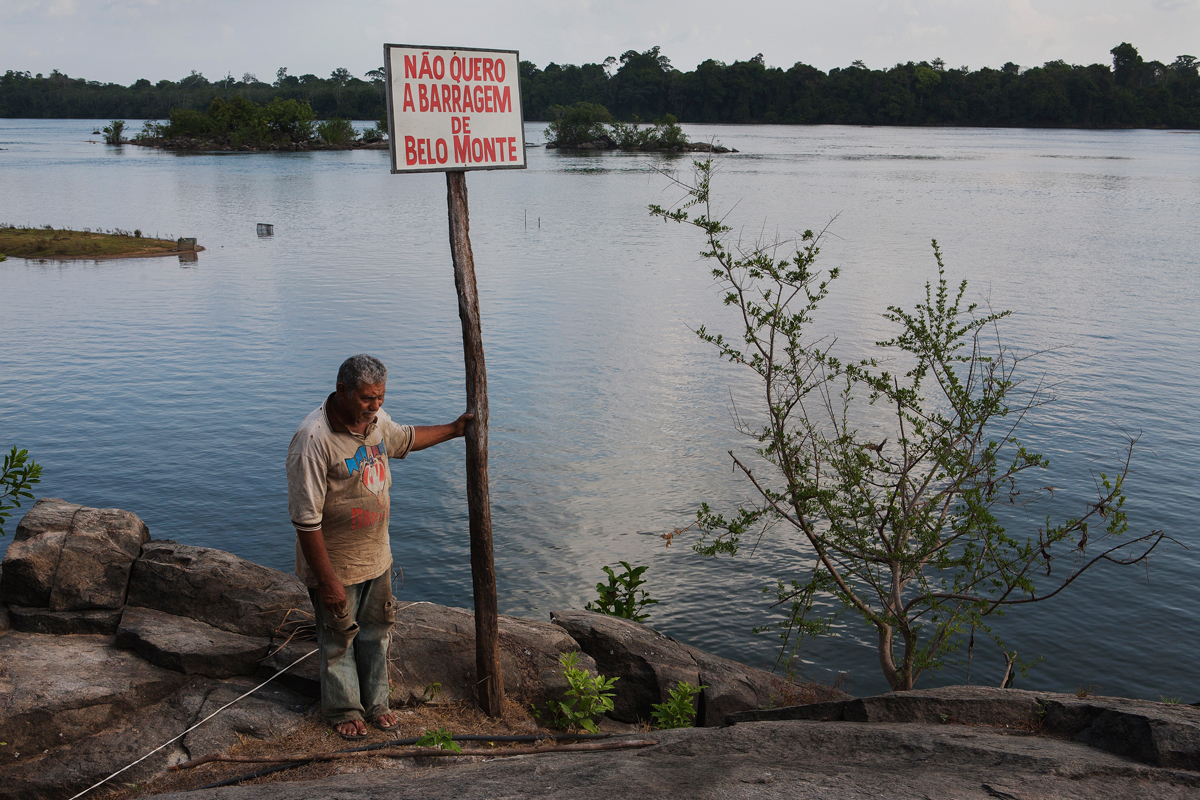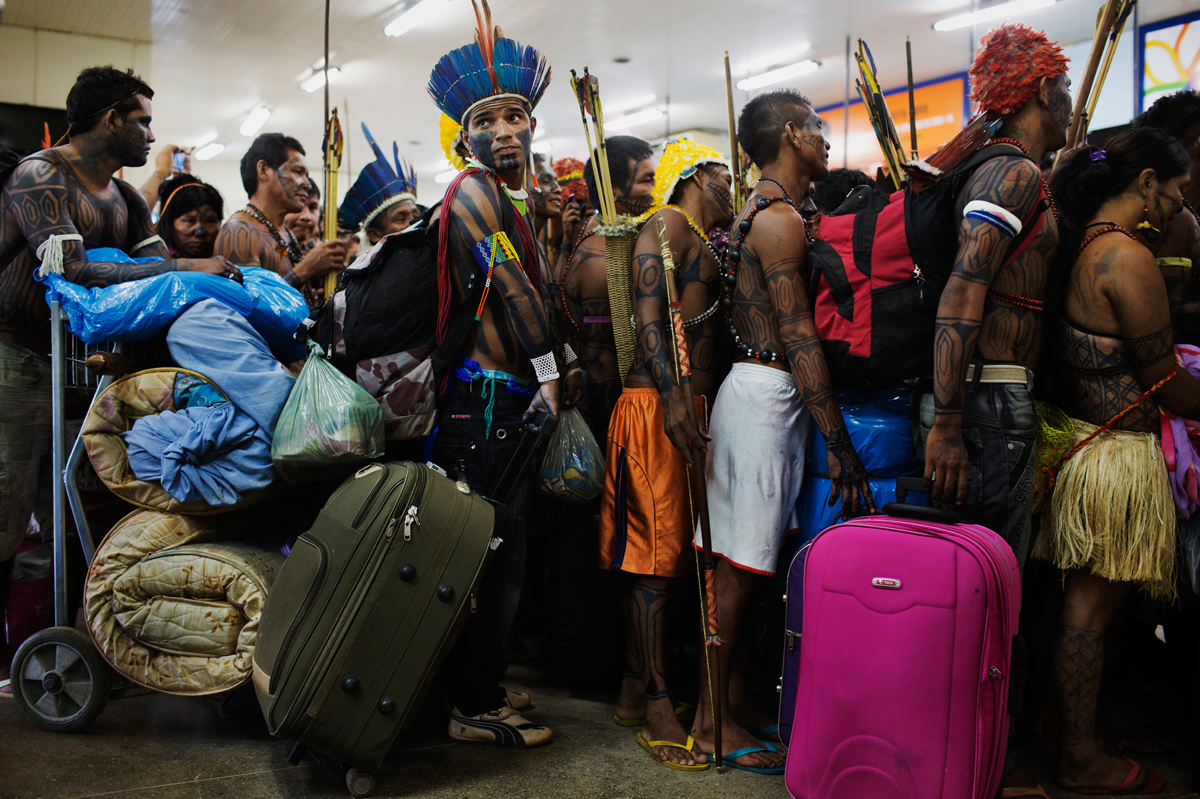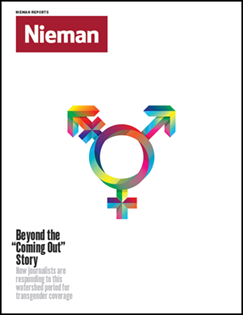
Many Brazilians oppose construction of the massive Belo Monte hydroelectric dam in the nation’s Amazon region
About 25 million people live in ever widening swaths of deforested areas. Some are newly arrived workers attracted by infrastructure projects, such as Belo Monte, the third largest hydroelectric dam in the world. Others are members of indigenous tribes who have had little or no contact with Western culture.
There are endless stories to be told in the Amazon—from climate change to the ongoing loss of indigenous cultures—but fewer and fewer media outlets still have the budgets for the flights, cars, and boats needed to reach and report in such remote areas. It is harder still to find the cash to maintain a permanent presence. In April, Folha de S.Paulo, the most influential newspaper in Brazil, closed its last bureau in the Amazon. (Disclosure: I am a senior reporter at the paper.) Twenty years ago, it had three bureaus in the region. The other main national newspapers, O Globo in Rio de Janeiro and O Estado de S. Paulo, closed their offices in the past few years, as did Veja, the country’s largest weekly newsmagazine.
The retreat of mainstream print media as it transitions to digital has not only impacted coverage of the Amazon but also beats as diverse as soccer and books. Brazilian journalism faces the same problems the industry does in the rest of the world—including declining ad revenue—and greater ones, as well. In 2015, six journalists were killed for their work, the third most of any country tracked by the Committee to Protect Journalists (CPJ). CPJ’s Carlos Lauria says attacks on journalists in Brazil have increased in the last five years, especially on independent journalists covering crime and politics outside of major cities.
Despite this, and the country’s fraught political and economic climate, entrepreneurial Brazilian journalists are striving to revitalize and reinvent the profession. Dozens of journalists are leaving traditional newsrooms and creating new niche media start-ups online, including Amazônia Real, working to report stories in the Amazon that legacy media aren’t; Brio, specializing in long-form narratives, and its sister publication Jota, focused on the Brazilian judiciary system; Ponte, covering mostly public security, human rights, and justice; Aos Fatos, a fact-checking platform; and Agência Pública, a news agency focused on investigative reporting on issues such as the impact of the Olympic Games preparations.
“These organizations are not focused on profit but rather are committed to producing quality journalism and to finding new forms of financing it,” says Natália Viana, one of three female journalists who founded Agência Pública in 2011. “The result is deeper, less hard news-based journalism. It is more personalized and open to experimentation.”
Many of these start-ups gained more visibility in 2013, when people took over the streets of major Brazilian cities to protest bus fare hikes. Unexpectedly, the size of the demonstrations grew and so did the range of issues, encompassing corruption, bias in corporate media, and police violence. The protests symbolized the end of a period of economic growth and optimism, when Brazil seemed poised to be “the China of Latin America.” Since then Brazilians have suffered a sharp economic slowdown. In the third quarter of 2015, the world’s eighth largest economy shrank by 4.5 percent, the largest reduction since Brazil began measuring GDP by the current system in 1996. Many now wonder whether Brazil will become the next Greece.
Part of the economic crisis is attributed to a major corruption scandal in state oil company Petrobras. The investigation has affected all major political parties, especially the ruling Workers’ Party and President Dilma Rousseff, who chaired the Petrobras board from 2003 until she assumed office in 2010. In early December, Eduardo Cunha, the president of Brazil’s lower house of Congress who is also linked to the scheme, opened an impeachment procedure against Rousseff. The result has been a standoff, with each accusing the other of corruption.
During 2013’s electrifying marches “against everything,” as many people called them at the time, real-time coverage from citizens and activists using Twitter, TwitCasting, and other social media made a major impact. These emerging forms of coverage—practiced most prominently by Mídia Ninja, a Portuguese acronym for Independent Narratives, Journalism and Action—thrived due to better access to protest organizers and the public’s distrust of legacy media. Ninja has had less impact after one of its founders, journalist Bruno Torturra, left to create a new digital media initiative called Fluxo, but its early success highlighted the limits of traditional outlets and the possibilities for innovation.

Members of the Munduruku tribe await a flight to Brasilia, Brazil’s capital, to talk to government officials about the Belo Monte dam
“The idea is to publish news about the Amazon ignored by the local and national press, lending voice to distant populations,” says Katia Brasil, who started the website after losing her job at Folha de S.Paulo in one of the waves of layoffs occurring at Brazil’s top print publications. “At Amazônia Real, narratives begin with the characters. The characters lead us to investigate the issues,” says co-founder Elaíze Farias, a former senior reporter with local newspaper A Crítica.
One recent story chronicled the daily lives of four Juma, the sole remaining members of this ancient ethnic group that had a population of some 15,000 in the 18th century. Since then, the Juma have declined as the result of decades of conflict with rubber plant and chestnut tree growers, who have sought more and more land for their crops. The Juma seem doomed, as the only survivors are 80-year-old Aruká and his three daughters, who married men from another ethnicity.
In 2014, Brasil and freelance photographer Odair Leal made about a 1,370-mile round-trip from Manaus by plane, car, and boat to report the story. The result is a sad account in both text and video about Aruká, who cannot talk to his grandchildren because they didn’t learn the Juma language. Living in quasi-isolation, the Juma appear trapped between the traditional life of subsistence agriculture and fishing and a desire for modernization, such as formal education and electricity, while still facing pressure from lumbermen, fishermen, and hunters looking to use their land.
In October, Amazônia Real was the first media outlet to report on the link between the smoke that covered Manaus for several days and fires from nearby forests, disputing the official explanation from the regional government, which blamed the neighboring state of Pará. Gradually, the local press stopped quoting the regional government sources and started to use the scientific evidence reported by Amazônia Real.
Brazil’s Grupo Globo is the third fastest-growing media company in the world
Start-ups such as Amazônia Real—and many in the mainstream media—face an increasing challenge from powerful conglomerate Grupo Globo. It is the third fastest-growing media company in the world, with revenue in 2014 reaching about $7 billion, according to ZenithOptimedia. Globo maintains a national network of 118 local TV affiliates, owns the national O Globo newspaper, the weekly newsmagazine Época, the CBN national news radio network, and 24-hour channel GloboNews. The Economist, which has called Globo “Brazil’s most powerful company,” reported in 2014 that 91 million people—slightly less than half the population—tune into TV Globo every day. In the U.S., that sort of audience is only seen once a year, during the Super Bowl.
Recent data shows that more advertising revenue is migrating to Globo. “Increasingly, Brazil’s advertising market will be a contest between the two Gs: Globo and Google,” predicted The Economist.
In 2006, Globo launched G1, the most visited news site in Brazil, with some 25.2 million unique visitors a month. In comparison, Brio reports that it had just over 65,000 unique visitors during its first four months, while Amazônia Real says it averages around 50,000 unique visitors per month. In partnership with local TV affiliates, G1 maintains 57 newsrooms throughout the country, each one with its own regional news site.
No other media outlet in Brazil comes close to having Globo’s reach, but its ownership structure throws up conflicts of interest. This is especially true outside the major urban centers, where affiliates usually are owned by politicians or well-connected businessmen. For instance, the families of two former presidents, José Sarney and Fernando Collor, control local Globo affiliates in their impoverished home states.
Meanwhile, foreign media outlets like BuzzFeed, Vice, The Huffington Post, and Spain’s El País have encroached on Brazil’s digital landscape, one of the world’s largest online markets. BuzzFeed Brasil, which launched in October 2013 with translated content and is now operated by a local team producing original material, is BuzzFeed’s third largest site after the U.S. and U.K. Currently, the site focuses on social rather than hard news, but that may soon change. BuzzFeed recently listed an opening for a news editor at the site’s São Paulo office. The job qualifications include experience in large newsrooms, dealing with breaking news, and familiarity with Brazilian law.
Despite massive competition from legacy media and foreign-born initiatives, some niche start-ups feel they can offer an alternative—or at least a supplement—to content available elsewhere, an important shift in the journalism ecosystem. Brazil’s news media “is transitioning to a more fragmented landscape, but I won’t be naïve to think it means traditional outlets will lose their relevance,” says Tai Nalon, a former political reporter for Folha de S.Paulo and co-founder of the fact-checking start-up Aos Fatos. These new outlets “cover a niche in the best way possible, something mainstream media never did.”
Nalon launched Aos Fatos (“The Facts”) this past summer, in the hope of reshaping political coverage in the country. Though national political coverage is dynamic and widespread, with major media outlets committed to balance and accuracy, state and local news outlets are often heavily dependent on government funding. This, coupled with the number of politician-owned media companies located outside the major cities, means many smaller outlets are susceptible to biased coverage.
Aos Fatos’s biggest story to date came after embattled President Rousseff, in an August interview with three of Brazil’s major newspapers, stated that the government was unaware of the severity of the country’s mounting economic crisis until well into 2014. After fact-checking the president’s remarks, Aos Fatos demonstrated that the official economic figures started to deteriorate several months before Rousseff officially acknowledged the problem and the government’s own analysis was predicting a downturn as early as December 2013.
Fact-checking start-up Aos Fatos is reshaping political coverage in Brazil
With a steadily growing following on social media, Aos Fatos has proven it can attract an audience. Attracting funding, though, is another matter. “Scarce venture capital is the main obstacle,” says Nalon. “We don’t have a thriving ecosystem of foundations to support the emerging scene of independent media organizations. Most newspapers and magazines rely on income from a few companies or the government.” That’s why Nalon is depending on crowdfunding from readers to support her venture.
Aos Fatos’s business model, while common elsewhere, is unfamiliar in Brazil, which lacks a philanthropic tradition, according to Brazilian journalist Rosental Alves, professor of journalism at the University of Texas at Austin and director of the Knight Center for Journalism in the Americas. “There is some hope for nonprofit journalism,” he says. “The business of legacy journalism is shrinking so much that nonprofits can be created and be sustainable.”

The Belo Monte dam being built in the Amazon, home to the world’s most diverse rainforest, has aroused concern about its environmental impact
Other start-ups with nontraditional funding models include two co-founded by Felipe Seligman, who in 2013 left his job as a justice reporter with Folha de S.Paulo to start Brio, a Brasilia-based site that publishes long, intensively reported multimedia narratives, and its sister publication, Jota, focused on the Brazilian judiciary system. “I sensed the profession was going through a transitional moment,” Seligman says of his decision to launch his own ventures, “and that many colleagues would like to get involved in interesting models of journalism.”
Along with partners who have long experience in traditional newsrooms, Seligman first launched Jota, aimed at the nearly 1 million lawyers, judges, and prosecutors that deal with more than 95 million lawsuits nationwide. “I noticed a big dissatisfaction among lawyers regarding access to justice information,” he says. “They always complained that [journalists] gathered much more information than them.” Jota says it has a little over 1,000 subscribers, who either pay $5 a month or an annual fee of $50. The website also offers products on demand, modeled after The Economist Intelligence Unit. The growing popularity of the service indicates how providing must-read information to niche audiences for a fee could be a sustainable path for certain publications.
Then, last May, Seligman and his partners launched Brio, which plans to publish one long-form narrative story per month. Brio initially experimented with its own publishing platform but is now posting all of its articles on the free site Medium. When the site launched, Seligman’s co-founder, Fernando Mello, another former Folha reporter, outlined Brio’s mission in a Medium post: “Brio commits to make life easier for journalists during the creative process, by way of expense advances, rigorous research and editing process, translation to English and Portuguese and marketing and PR campaigns created in-house, specifically for each story.”
Brio’s stories have so far ranged from a consideration of who will succeed the current Dalai Lama to an exploration of the legacy of the military dictatorship that ruled Brazil from 1964 to 1985. The piece that has garnered the most attention has been reporter Matheus Leitão’s personal account of his search for the man who informed on his parents, former Communist Party militants. In the 1970s, the couple was arrested and tortured at the behest of the country’s military dictatorship.
The first-person narrative begins when 12-year-old Leitão learns that in 1972 his parents, Marcelo Netto and Miriam Leitão, then undergrads and now journalists, had been jailed for their militancy as part of the Brazilian Communist Party. Nineteen years old and pregnant with Matheus’ older brother, Miriam Leitão was locked in a dark room with a 110-pound snake and beaten by the guard. Netto was repeatedly beaten and spent nine months in solitary confinement.
The person who informed on them is Foedes dos Santos. A communist leader in the southeastern state of Espírito Santo, he also had been arrested and, under torture, named some 20 other students as well as a Communist Party member, who died in jail. He then cut all ties with his former colleagues and vanished. After several years of research, Matheus Leitão found dos Santos living with his son in a remote rural area, 42 years after his disappearance.
The multimedia piece received hundreds of comments on Brio’s site and via social media and was covered by several other outlets. Leitão also signed a contract to write a book about his quest. “I had never gotten so much feedback,” says Leitão, a former Folha reporter and now a political blogger with G1 and Época. Brio’s platform “matched perfectly” the way he wanted to tell the story, he says. “There are new formats that allow a certain kind of freedom that the big media outlets have not found yet.”
Despite the promise of these new startups, Eliane Brum, a columnist for El País’s international edition and a documentary filmmaker who often reports on human rights issues, doesn’t think they are up to the task of reporting on the country’s complexities. The mainstream media haven’t lived up to their role in a democracy, she argues, but neither have these new initiatives completely filled the demand for in-depth reporting and new narrative forms. “My great concern is that such a fascinating period of Brazilian history has been told in a very precarious way or even not told at all,” Brum says, “as there is too little reporting and enormous parts that have been made invisible. There is no media outlet, large or small, that can be considered truly national in the sense of daily coverage of the various countries inside Brazil.”
With reporting by Eryn M. CarlsonStill, Seligman, for one, is encouraged by what his and other niche titles have accomplished so far. “There is a wealth of stories and a lot of good people to write for us,” he says. “The challenge now is to attract readers’ interest.”


